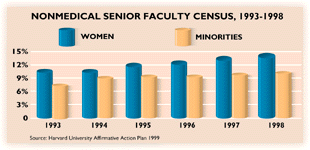![]()
Main Menu ·
Search ·
Current Issue · Contact · Archives · Centennial · Letters to the Editor · FAQs
![]()
Main Menu ·
Search ·
Current Issue · Contact · Archives · Centennial · Letters to the Editor · FAQs


|
Harvard's affirmative-action plan for 1999, published in June, details continuing measured growth in the number of female and minority faculty members throughout the University's schools.
Excluding the medical and dental schools, whose thousands of appointments at affiliated hospitals distort the data, 113 of 785 tenured faculty members during 1998 were women and 80 were minorities--14.4 percent and 10.2 percent, respectively. (Because of double-counting, 13 of the 80 minority faculty members also appear in the total of tenured women.) That represents an increase of 40 women, and 3.8 percentage points, during the past five years. The smaller number of tenured minority faculty members has grown by 23 professors--1.9 percentage points--in that time.
"Ladder" faculty--the associate and assistant professors who are occasionally appointed to tenured positions--show a different pattern. In 1998, women held 159 of the 490 positions, just under one-third of the total, a proportion little changed since 1993. Minorities held 97 ladder appointments--just under 20 percent of the total, and an increase of more than 6 percentage points in the past five years.
Within the Faculty of Arts and Sciences (FAS), women held 58 of the 433 tenured positions (13.4 percent of the total) and minorities 33 (7.6 percent). In all fields, FAS has a less diverse tenured faculty than the academic universe as a whole, as measured by "availability" data for eligible scholars in the respective disciplines--with women particularly underrepresented in the natural sciences, and minorities in the social sciences (see "Gender in the Humanities...and Beyond," May-June, page 70).
Among ladder faculty, women held 58 of 172 FAS appointments, one-third of the total--an "all-time high," the report notes. Here, Harvard's junior professors actually outnumbered the availability index in social sciences, but still lagged significantly in natural sciences. Minority junior faculty numbered 26 (15 percent), and exceeded the availability indexes for both social and natural sciences. Throughout the FAS ladder faculty, the number of women and minority scholars has held steady for five years, as the total number of junior professors has declined 20 percent.
Looking ahead, "the composition of the junior ranks is important," the FAS portion of the report notes, because "to the degree that their scholarly potential can be developed during the years prior to a tenure review, the potential pool for senior women and minority appointments will be strengthened." To that end, recent FAS increases in funding for research, and an additional term of paid leave for newly appointed associate professors in the humanities and social sciences, "contribute to the prospects for promotion to tenure."
Combined with extensive recruiting and other efforts, those initiatives are forecast to produce further gradual increases in faculty diversity. For 1999, FAS goals (again allowing for double-counting) called for the tenuring of three more women and two more minorities, and for the hiring of six more women and three more minorities in the junior faculty ranks.
Main Menu ·
Search · Current Issue · Contact · Archives · Centennial · Letters to the Editor · FAQs
![]()